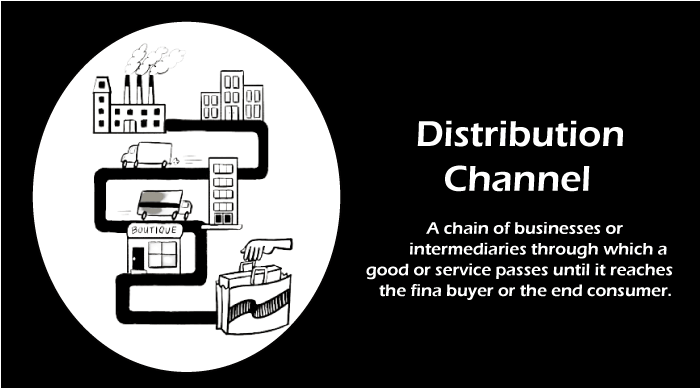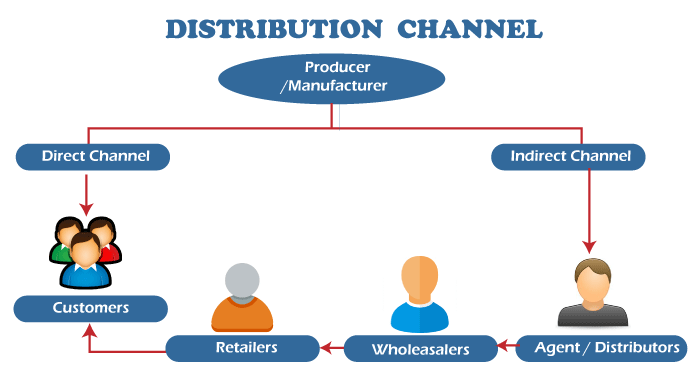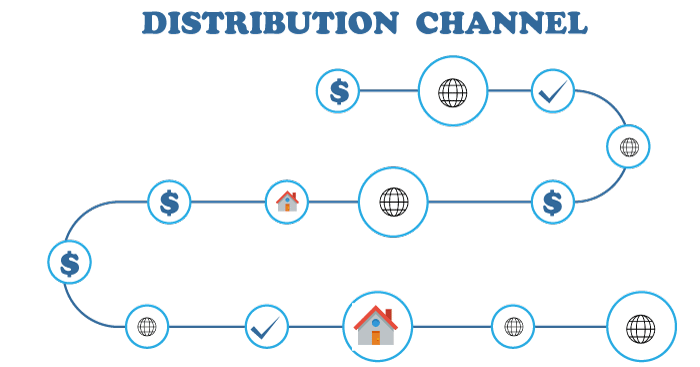What Is a Distribution Channel in Business and How Does It WorkWhat is a Distribution Channel?A channel of distribution is a system of businesses or intermediaries that a good or service passes through to get to the buyer or end consumer. Wholesalers, merchants, resellers, and even the web are examples of distribution channels. 
The downstream process addresses the issue of "How would we get our products to the customers", including distribution networks. As opposed to this, the upstream procedure, sometimes referred to as the distribution chain, responds to the query, "Who are our vendors?" The distribution channels explain how a product goes from the maker to the client. The complexity of these routes varies tremendously depending on the commodities. The most fundamental distribution channel is 'producers selling their goods directly to customers (such as a farmer doing so at a farmer's market)'. Key Takeaways
Understanding Distribution ChannelsA distribution channel is a route that all products and services must take to reach their target customers. On the other hand, it also specifies customers' payment route to pay the original provider. The number of intermediaries required to distribute an item or service determines the length of the distribution channel, forming a distribution chain. 
Services and goods can occasionally be delivered to clients in short-and-long-distance ways. Sales can increase by expanding the options for consumers to locate a product more easily. But, it can also lead to an intricate architecture that occasionally makes distribution management difficult. Longer distribution routes may also result in lower profit margins charged by each mediator to the manufacturer. Only a few media directly address customers. Several, such as a platform for organisation marketing, include interactions between two different organisations. A technological business could produce a component for internal use, such as a computer chip, and then sell it to other manufacturers so they can construct hardware parts. Companies may conclude that internalising a process and producing it in-house may be more economical, reduce the cost of the goods or services, and increase profits. Vertical integration may also be seen in this situation. Other routes are far more intricate; a product may first pass through producers, dealers, wholesalers, and retailers before it is delivered to the client. They fall into two categories: direct channels and indirect channels. A direct route enables clients to purchase goods directly from the manufacturer, as opposed to an indirect system, which allows them to do so through wholesalers or merchants. Direct and Indirect ChannelsDirect and Indirect channels fall into two categories into which they are divided. A direct route enables clients to purchase goods directly from the manufacturer, as opposed to an indirect system, which allows them to do so through wholesalers or merchants. For products offered in conventional brick-and-mortar establishments, indirect channels are usual. In general, if there are more intermediaries in the supply chain, the price of an item might increase. On the other hand, if a client takes a direct or quick path, they may pay less since they are dealing directly with the producer. Types of Distribution ChannelsEven though there are three primary distribution channels, each combining a manufacturer, wholesaler, and retailer user, a medium may occasionally appear limitless. Since it covers four parties-producer, wholesaler, retailer, and consumer-the distribution channels are considered to be three. The first channel is the longest. The wine and grownup drinks sector is the ideal illustration of this extensive distribution network. Due to pre-Prohibition era regulations, wines are not allowed to be sold directly to shops in this industry. It adheres to the three-tier structure, in which the vineyard sells its products to a distributor, who then distributes them to a retailer. The goods are subsequently sold to the final customer by the authorised stores. The second channel eliminates the wholesaler by selling straight to a retailer, who then sells the item to the final customer. This implies that the second channel has just one middleman. For instance, Dell is big enough to sell its goods directly to dependable stores like Best Buy. A direct-to-consumer model, the third and last channel, allows the manufacturers to sell their goods to the final customer directly. Amazon, which offers Kindles for sale to its customers on its marketplace, is an example of a direct business. Since the distributor and the merchant are eliminated, this is the smallest distribution chain imaginable. Choosing the Right Distribution TableBusinesses must choose the proper distribution channel because only some channels are effective for all items. The previous track records should align with the company's overarching strategic aims, including its general mission. The primary aim of the distribution strategy is to benefit the consumer while generating profits for the manufacturer. Customers, do you wish to talk to a salesperson? Before they buy, will they like to touch the product? Companies can pick the best channel by responding to these questions. The second thing the business should consider is how soon it wants its product(s) to get to the customer. While certain products, like poultry or fruit, benefit more from direct marketing, others could do better with an indirect approach. The distribution methods a business uses, such as selling things digitally and through a shop, shouldn't compete with one another. They must try to maintain and balance different approaches equally. What is a distribution channel, and what are its components?
The ways a business conveys its goods or services to the end customer are described as "distribution channels". A network of intermediate companies, including producers, distributors, and retailers, is frequently involved. One of the most critical aspects of managing distribution networks is choosing and observing distribution networks. What is the Difference between Direct and Indirect Distribution Channels?Direct distribution channels let a product maker or service provider interact with the final consumer directly. A company that manufactures apparel and later sells it to clients through an online store illustrates a direct distribution channel. On the other hand, if the same business relied on a system of many distributors and retailers to market its goods, it is an example of an indirect distribution platform. What are the 3 primary Distribution Channels?The distribution channels are retailers, distributors, and direct sales. Wholesalers are intermediary businesses that get commodities in bulk from producers and resell them to retailers or, sporadically, to end users. Retailers provide high-touch customer care to end users and are typically wholesalers' clients. Last but not least, direct-to-consumer sales occur when the manufacturer sells to the final consumer directly, for example, when the transaction is done through an e-commerce platform. |
 For Videos Join Our Youtube Channel: Join Now
For Videos Join Our Youtube Channel: Join Now
Feedback
- Send your Feedback to [email protected]
Help Others, Please Share









